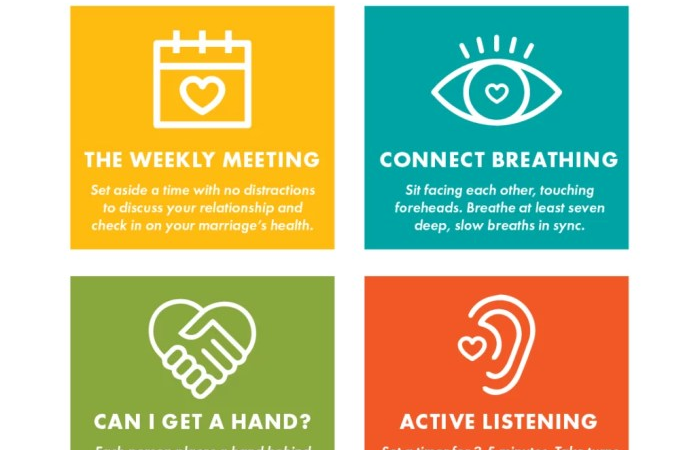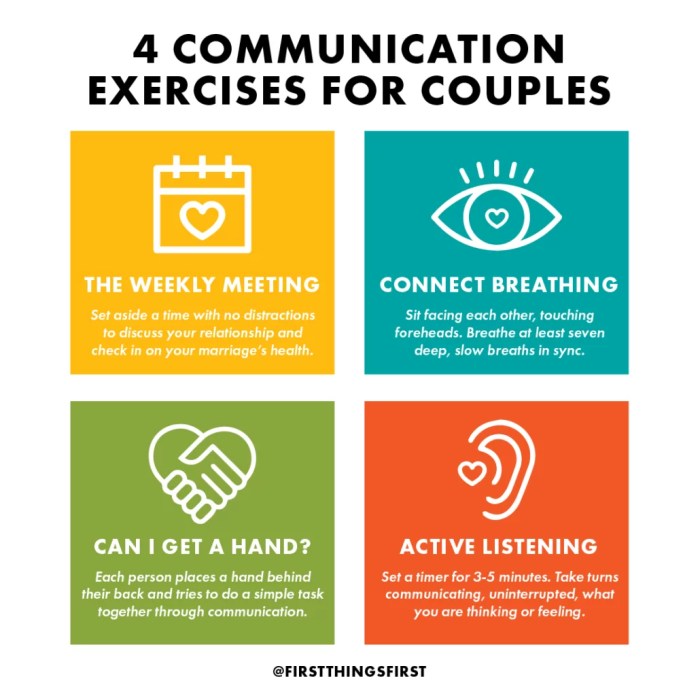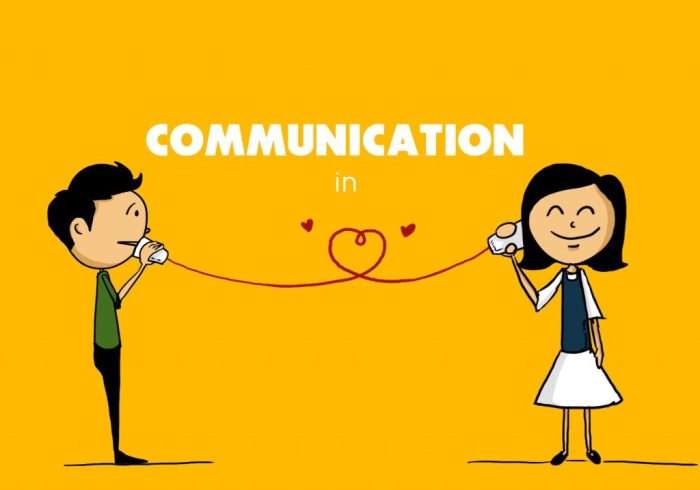Effective Communication for Couples: Building Stronger Bonds

Effective communication for couples is the cornerstone of a healthy and fulfilling relationship. It’s not just about talking; it’s about truly understanding each other’s thoughts, feelings, and needs. By learning to communicate effectively, couples can navigate challenges, build intimacy, and foster a deep connection that stands the test of time.
This guide explores the essential principles of effective communication, providing practical tips and strategies for couples at all stages of their relationship. From understanding the importance of active listening and identifying communication barriers to developing healthy communication habits, this comprehensive resource equips couples with the tools they need to build a stronger, more loving bond.
Understanding Effective Communication
Effective communication is the cornerstone of any healthy and fulfilling relationship. It is the foundation upon which trust, intimacy, and understanding are built. When couples communicate effectively, they can navigate challenges, celebrate successes, and foster a deeper connection.
Open and Honest Communication
Open and honest communication is essential for building trust and fostering a strong connection in a relationship. When couples are open with each other, they create a safe space for vulnerability and authenticity. This means being willing to share thoughts, feelings, and experiences, even if they are difficult or uncomfortable.
Honesty ensures that both partners are on the same page and prevents misunderstandings from festering.
Active Listening
Active listening is a crucial aspect of effective communication. It involves paying full attention to your partner, not just hearing their words but also understanding their emotions and perspectives. This means making eye contact, nodding, and asking clarifying questions. It also involves putting aside distractions and focusing on what your partner is saying.
Active listening shows your partner that you value their thoughts and feelings, fostering a sense of respect and understanding.
Communication Barriers
Couples often face communication barriers that can hinder their ability to connect effectively. These barriers can include:
- Defensiveness: When one partner feels attacked or criticized, they may become defensive and shut down, making it difficult to have a productive conversation.
- Mind Reading: Assuming you know what your partner is thinking or feeling without asking can lead to misunderstandings and frustration.
- Stonewalling: Withdrawing from a conversation or refusing to engage can create a sense of distance and isolation.
- Criticism: Attacking your partner’s character or personality can damage their self-esteem and make them less likely to open up.
- Contempt: Expressing disdain or disrespect for your partner can erode the foundation of the relationship.
Non-Verbal Communication Cues
Non-verbal communication cues, such as body language, facial expressions, and tone of voice, can significantly impact the way a message is received. For example, a warm smile and gentle touch can convey love and affection, while a furrowed brow and crossed arms can indicate anger or displeasure.
Understanding these cues can help couples interpret their partner’s messages more accurately and avoid misunderstandings.
“Non-verbal communication is often more powerful than words, as it conveys our true feelings and intentions.”
Developing Communication Skills

Effective communication is the foundation of a strong and fulfilling relationship. It allows partners to understand each other’s needs, feelings, and perspectives, fostering empathy, intimacy, and a sense of connection. Developing strong communication skills requires conscious effort and a willingness to learn and grow together.
Expressing Needs and Feelings Clearly and Respectfully, Effective communication for couples
Clear and respectful communication is essential for understanding and meeting each other’s needs. It involves expressing your feelings and thoughts in a way that is both honest and considerate of your partner’s feelings.
- Use “I” statements: Instead of blaming or accusing, focus on your feelings and experiences. For example, instead of saying “You always make me feel ignored,” try “I feel ignored when I don’t hear from you for a while.” This approach encourages empathy and reduces defensiveness.
- Be specific: Vague statements can lead to misunderstandings. Instead of saying “You’re not listening,” try “I feel like you’re not listening when you interrupt me while I’m talking.” This provides your partner with clear information about what you’re experiencing.
- Choose the right time and place: Avoid discussing sensitive topics when you’re tired, stressed, or distracted. Find a time when you can both focus on the conversation and feel safe to express yourselves openly.
- Listen actively: Active listening demonstrates that you care about your partner’s perspective. Pay attention to what they are saying, both verbally and nonverbally.
- Validate your partner’s feelings: Even if you don’t agree with their perspective, acknowledge their feelings and show empathy. For example, you could say, “I understand that you’re feeling frustrated about this.”
Resolving Conflicts Constructively
Disagreements are inevitable in any relationship. Developing a constructive approach to conflict resolution is essential for maintaining a healthy and harmonious partnership.
- Choose the right time and place: Similar to expressing needs and feelings, it’s crucial to address conflicts when you’re both calm and ready to have a productive conversation. Avoid discussing sensitive topics when you’re tired, stressed, or distracted.
- Focus on the problem, not the person: Avoid blaming or attacking your partner. Instead, focus on the specific issue at hand and work together to find a solution.
- Use “I” statements: As discussed previously, using “I” statements can help you express your needs and feelings without blaming your partner.
- Listen actively and empathize: Try to understand your partner’s perspective and acknowledge their feelings.
- Take breaks if needed: If the conversation becomes heated, take a break to calm down and collect your thoughts.
- Seek compromise: Finding a solution that works for both of you requires compromise. Be willing to consider your partner’s needs and find common ground.
Active Listening and Understanding Your Partner’s Perspective
Active listening is a powerful communication skill that allows you to truly understand your partner’s perspective. It goes beyond simply hearing the words they say; it involves paying attention to their non-verbal cues, asking clarifying questions, and reflecting on what you’ve heard.
- Focus your attention: Put away distractions and give your partner your full attention. Make eye contact, nod your head, and avoid interrupting.
- Ask clarifying questions: To ensure you understand what your partner is saying, ask open-ended questions that encourage them to elaborate.
- Reflect on what you’ve heard: Summarize what you’ve understood to ensure you’re on the same page. For example, you could say, “So, it sounds like you’re feeling frustrated because…”
- Avoid interrupting: Let your partner finish their thoughts without interrupting. Even if you disagree, it’s important to listen respectfully and allow them to express themselves fully.
- Empathize with their feelings: Even if you don’t agree with their perspective, acknowledge their feelings and show empathy.
Communication Exercises to Strengthen Relationships
Engaging in communication exercises can help you and your partner develop stronger communication skills and deepen your connection.
- “I” statement practice: Take turns expressing your needs and feelings using “I” statements. Focus on being specific and clear.
- Active listening practice: Take turns sharing your thoughts and feelings, while the other person practices active listening.
- Role-playing: Practice difficult conversations by role-playing different scenarios.
- “What I appreciate about you” exercise: Take turns sharing things you appreciate about each other.
- “We” statements: Practice using “we” statements to emphasize shared goals and experiences.
Maintaining a Healthy Communication Style: Effective Communication For Couples
Effective communication is the foundation of a strong and lasting relationship. While understanding the principles and developing essential skills are crucial, maintaining a healthy communication style is equally important. This involves fostering an environment of respect, empathy, and understanding, which allows both partners to feel heard, valued, and safe to express themselves freely.
Setting Boundaries and Respecting Space
Setting boundaries is crucial for maintaining a healthy communication style. Boundaries define personal limits and expectations in a relationship. They help individuals protect their emotional and physical well-being while allowing for healthy interdependence.
- Respecting Individual Time and Space: Every individual needs personal time and space for self-reflection, relaxation, and pursuing personal interests. Respecting each other’s need for solitude and time alone is essential for maintaining a healthy balance in the relationship. For example, a partner might need time to unwind after work by reading a book or engaging in a hobby, while the other partner might prefer spending time with friends or family.Recognizing and respecting these individual needs fosters a sense of autonomy and allows each partner to recharge.
- Communicating Needs and Expectations: Open and honest communication about personal needs and expectations is essential for setting clear boundaries. This involves articulating individual preferences, limitations, and non-negotiables. For example, one partner might need regular communication throughout the day, while the other might prefer limited contact.Expressing these needs and expectations openly helps avoid misunderstandings and fosters a sense of mutual understanding.
- Negotiating and Compromising: Setting boundaries does not mean being inflexible or demanding. It involves finding a balance between personal needs and the needs of the relationship. This often requires negotiation and compromise, where both partners are willing to adjust their expectations to accommodate each other’s needs.For example, one partner might agree to limit their social activities on certain days to spend more time with their partner, while the other partner might agree to be more responsive to their partner’s needs for communication.
Navigating Difficult Conversations and Emotional Triggers
Difficult conversations are an inevitable part of any relationship. They often involve sensitive topics, differing opinions, or unresolved conflicts. Navigating these conversations effectively requires patience, empathy, and active listening.
- Choosing the Right Time and Place: Initiating a difficult conversation when both partners are calm, relaxed, and have ample time to dedicate to the discussion is crucial. Avoid bringing up sensitive topics when either partner is stressed, tired, or distracted.
- Focusing on “I” Statements: Using “I” statements instead of accusatory “you” statements helps to express personal feelings and perspectives without blaming or attacking the other partner. For example, instead of saying “You always make me feel ignored,” one might say, “I feel ignored when I don’t hear from you during the day.”
- Active Listening: Active listening involves paying full attention to the other partner’s perspective, acknowledging their feelings, and seeking clarification when needed. It involves avoiding interrupting, judging, or offering unsolicited advice.
- Taking Breaks: If the conversation becomes heated or unproductive, taking a break to calm down and regroup can be beneficial. This allows both partners to process their emotions and return to the conversation with a calmer and more receptive mindset.
The Role of Forgiveness and Empathy
Forgiveness and empathy are essential for maintaining healthy communication in relationships. Forgiveness involves releasing resentment and anger towards a partner, while empathy involves understanding and acknowledging their perspective and feelings.
- Understanding the Importance of Forgiveness: Holding onto resentment and anger can damage a relationship and prevent open communication. Forgiveness does not mean condoning hurtful behavior but rather choosing to move forward from the past and focus on building a healthier future.
- Cultivating Empathy: Empathy involves putting yourself in your partner’s shoes and trying to understand their perspective, even if you don’t agree with it. It involves listening with an open mind, acknowledging their feelings, and seeking to understand their motivations.
- The Power of Apologies: Sincere apologies are crucial for repairing hurt feelings and rebuilding trust. A genuine apology involves acknowledging responsibility for hurtful actions, expressing remorse, and making amends.
Building Trust and Intimacy Through Effective Communication
Effective communication plays a vital role in building trust and intimacy in a relationship. Open and honest communication fosters a sense of connection, understanding, and shared experiences.
- Sharing Vulnerability: Vulnerability involves sharing your thoughts, feelings, and fears with your partner, creating a space for emotional intimacy. It requires trust and a willingness to be open and honest, even when it feels uncomfortable.
- Expressing Appreciation and Affection: Regularly expressing appreciation and affection through words, gestures, and actions strengthens the bond between partners. It reminds them of their value and importance in the relationship.
- Creating Shared Experiences: Engaging in activities together, whether it’s going on a date night, trying a new hobby, or simply spending time together, creates shared memories and strengthens the connection between partners.
Communication in Different Stages of Relationships

Communication styles and challenges evolve as relationships progress through different stages. Understanding these shifts is crucial for fostering healthy and fulfilling connections.
Communication in Dating Relationships
Dating relationships are characterized by a focus on getting to know each other and building attraction. Communication during this stage is often exciting, playful, and filled with anticipation. Couples tend to:
- Engage in lighthearted conversations, sharing interests, hobbies, and dreams.
- Use a lot of positive language, compliments, and affectionate gestures.
- Focus on expressing their feelings and desires openly.
However, communication challenges can arise due to the novelty of the relationship:
- Fear of vulnerability and potential rejection.
- Difficulties in navigating boundaries and expectations.
- Limited understanding of each other’s communication styles and needs.
Effective communication strategies for dating relationships include:
- Active listening: Paying full attention to your partner’s words and non-verbal cues.
- Open and honest communication: Sharing your thoughts, feelings, and desires without fear of judgment.
- Empathy: Understanding and validating your partner’s perspective.
Communication in Marriage
Marriage marks a significant shift in the relationship, requiring deeper levels of intimacy, commitment, and communication. Communication styles often become more practical and focused on shared goals, responsibilities, and long-term plans. Couples may:
- Engage in more problem-solving conversations, tackling household issues, finances, and family matters.
- Develop shared routines and communication patterns that facilitate daily life.
- Prioritize open and honest communication about their needs and expectations.
However, communication challenges can arise due to the increased demands and responsibilities of marriage:
- Difficulties in balancing work, family, and personal time.
- Potential conflicts arise from differing opinions and values.
- Increased stress and fatigue can impact communication.
Effective communication strategies for married couples include:
- Regular check-ins: Scheduling dedicated time for open and honest conversations about the relationship.
- Conflict resolution skills: Developing healthy strategies for navigating disagreements and finding solutions.
- Appreciation and gratitude: Expressing appreciation for each other’s efforts and contributions.
Communication in Long-Term Relationships
Long-term relationships, spanning years or even decades, present unique communication challenges and opportunities. Couples often develop a deep understanding of each other’s communication styles, needs, and values. They may:
- Communicate with greater ease and fluency, relying on shared history and experiences.
- Develop a more comfortable and relaxed communication style, often using humor and inside jokes.
- Engage in deeper conversations about life’s meaning, purpose, and shared dreams.
However, communication challenges can arise due to the potential for complacency and routine:
- Difficulties in maintaining excitement and novelty in the relationship.
- Potential for communication patterns to become predictable and stale.
- Challenges in adapting to life changes and transitions, such as retirement, illness, or the loss of loved ones.
Effective communication strategies for long-term relationships include:
- Continual self-awareness: Reflecting on your communication style and its impact on the relationship.
- Seeking new experiences together: Engaging in activities that foster connection and create new memories.
- Prioritizing quality time: Making a conscious effort to spend quality time together, engaging in meaningful conversations.
Communication and Technology

The advent of technology has profoundly impacted how we communicate, particularly in relationships. While technology offers many advantages for enhancing communication, it also presents potential pitfalls that can strain relationships. Understanding both the benefits and drawbacks of technology in communication is crucial for navigating modern relationships.
Impact of Technology on Communication
Technology has revolutionized communication in relationships, offering numerous benefits. It has made it easier and faster to stay connected with partners, even when geographically separated. Social media platforms and instant messaging apps facilitate frequent communication, enabling couples to share updates, photos, and emotions in real time.
Technology also provides a platform for couples to express affection, support, and appreciation through virtual means.
Using Technology Effectively to Enhance Communication
Using technology effectively can strengthen relationships by promoting meaningful communication. Here are some tips for using technology to enhance communication:
- Schedule Dedicated Time for Quality Conversations: Despite the convenience of technology, it’s essential to prioritize quality time for face-to-face conversations. Schedule regular time to put away devices and engage in meaningful dialogue.
- Use Technology for Creative Expression: Technology offers creative avenues for expressing love and appreciation. Use video calls for a more intimate experience, send personalized messages, or create digital photo albums to express your feelings.
- Leverage Technology for Shared Experiences: Utilize technology to create shared experiences, such as watching movies together virtually, playing online games, or participating in virtual events. These shared activities can strengthen bonds and foster a sense of togetherness.
Potential Pitfalls of Technology in Communication
While technology offers benefits, it can also pose challenges to communication in relationships. Here are some potential pitfalls:
- Distraction and Lack of Presence: Constant notifications and the allure of social media can distract from the present-moment connection. It’s important to be mindful of technology use and prioritize quality time together.
- Misinterpretation and Miscommunication: Text-based communication can be misinterpreted due to the lack of nonverbal cues. It’s crucial to be mindful of tone and context when communicating digitally.
- Overreliance on Technology: Excessive reliance on technology can create a barrier to genuine connection. Make an effort to engage in face-to-face conversations and prioritize in-person interactions.
Strategies for Navigating the Pitfalls of Technology in Communication
Navigating the potential pitfalls of technology in communication requires conscious effort and clear boundaries. Here are some strategies:
- Establish Technology Boundaries: Set clear guidelines for technology use in your relationship. For instance, agree on specific times to put away devices or designated areas where technology is off-limits.
- Prioritize Face-to-Face Communication: Make a conscious effort to engage in face-to-face conversations, even if it’s just for a few minutes each day. This helps maintain a sense of connection and intimacy.
- Practice Active Listening: When communicating digitally, practice active listening by paying full attention to your partner’s message, avoiding distractions, and responding thoughtfully.
- Be Mindful of Tone and Context: Be mindful of the tone and context of your digital messages to avoid misinterpretations. Use emojis or other cues to clarify your intended meaning.
- Address Technology-Related Issues Openly: If technology is creating tension in your relationship, address it openly and honestly with your partner. Communicate your concerns and work together to find solutions.
Closing Notes

Mastering the art of effective communication is a journey, not a destination. It requires ongoing effort, patience, and a willingness to learn and grow together. By embracing open and honest communication, couples can create a safe and supportive space where they can thrive individually and as a unit.
Remember, communication is the lifeblood of any relationship, and investing in it is an investment in your shared future.
Comments are closed.